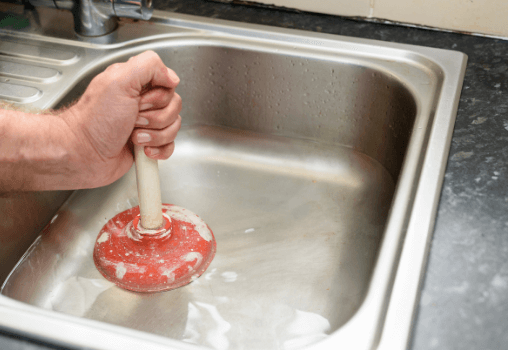Why Isn’t My Sink Draining Properly?
Have you ever noticed how your sink does not drain away liquid as quickly as it used to? Or water from your shower pools up as you use it? Over time, this can get worse, preventing fewer liquids from flowing efficiently down the drain until you reach a complete blockage.
It can be very frustrating to deal with, especially with extreme blockages that make your sink or shower almost impossible to use. Here at Bates Environmental, we specialise in what causes drain blockages and how to treat them, so we have put together a helpful blog to raise awareness of the problems you may come across.

Causes
Whether it’s your bathroom or kitchen, both can become severely blocked if not properly maintained. A heavy build-up of hair and grease are prime reasons why households experience blocked drains, so we will be breaking down how to prevent this!
Kitchen sink -
- Food and grease - An obvious one that can cause severe blockages is food and grease. Nothing should be going into your sink unless it is a liquid, but even then, things like oil and grease cause major issues for drains as they can stick to the pipe walls and builds up over time. This is not only an issue for common households but also the nation’s sewers. There are approximately 200,000 sewer blockages throughout the UK every year of which up to 75% are caused by fat, oil and grease.
What to do - All food waste should be put in the bin. For grease, pour the liquid into a sealable container and then once it cools, put it in the bin or take it to a recycling centre. Doing this does not only reduce the chances of your drain blocking, it also reduces the impact on the environment as well.
If your drain isn’t draining properly, then you can attempt to pour boiling water down the sink to soften the blockages. You may also use a traditional plunger, however, these methods have no guarantees, therefore you may need to call a professional like ourselves here at Bates Environmental. We can clear blockages at a low price by using rods or high pressure water jetting to efficiently remove this.
Get in contact with our expert team if you need a drain unblocking.
Bathroom drains -
- Hair - A very common drain blockage issue is the build-up of hair. Each time you shower or shave in the sink, these hairs will get caught together and will gradually build up; blocking the drain. You’ll notice this is an issue when you start to stand in a pool of water in your shower, or your bathroom sink takes longer to drain. An average person with a full head of hair loses 50 strands a day, so it doesn’t take long for this to occur without proper maintenance!
What to do - Aim to brush your hair before any bath or shower to remove loose hair. This will reduce the amount that ends up down the drain. There are also mechanisms you can purchase that essentially filters or catches these hairs before they make their way down the drain. You can use a mesh screen or a perforated shower drain hair catcher to ensure only water falls down. A shower drain catcher is also an option that will catch hairs that can easily be picked up and put in the bin.
If your drain isn’t draining properly, then there are a few measures you can take yourself to fix the issue. These include:
- Tweezers - To remove hair around the opening of the plug
- Bicarbonate of soda and vinegar - Pour this solution down the plughole to remove hair and grime.
- Plunger - If the blockage is deeply embedded in the pipework, a plunger may help to remove this.
- Drain cleaner - If these methods do not work, drain cleaners can be purchased to dissolve hair.
- Soap scum - Not only does hair cause many issues, but soap scum is another contributing factor to blockages. You may notice soap scum appear along with the tiles and edges of the tub. This dry soap is also lining the edges of the pipes in the bathroom and kitchen sinks. This scum is formed from the greasy substances used in shampoos and other cleaning products combined with mineral and calcification deposits in the water; causing blockages overtime.
If you are unsure if the blockage is due to hair, then we offer a CCTV drainage survey that will determine the issue. Find out more about this service here.
What to do - As mentioned previously, a mesh screen can be used over the drain to catch the soap scum before it causes any issues. However, if the damage has already been done, then these methods may help:
- Bicarbonate of soda and vinegar - Pour this solution down the plughole to remove soap scum.
- Boiling water - Pour boiling water down the drain to soften the soap scum and push it down.
- Drain cleaner - If these methods do not work, drain cleaners can be purchased to soap scum.
If you require any drain unblocking service, then please get in touch with us here at Bates Environmental. We have expertise in the design, supply, installation, servicing and repair for drainage systems.
